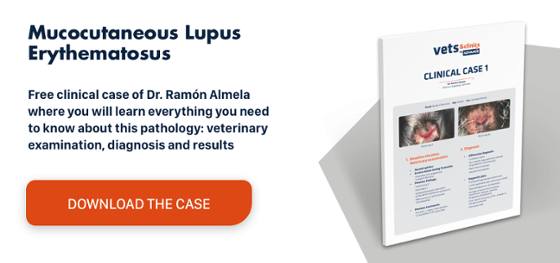GEDA: clinical cases in dermatology – Eloy Castilla
The first case presented by Eloy Castilla features a 16-month-old male English Setter with a 5‑day history of itchy skin lesions located around the nasal bridge. The patient had previously been seen for the same reason and was prescribed antibiotics and anti-inflammatories. The case’s evolution was complicated, and the lesions developed an ulcerative pattern. This indicated that the lesions were affecting the deepest layers of the dermis and not just superficial. The rest of the clinical examination revealed the patient had fever and retromandibular and popliteal lymphadenopathies. Upon exploring further, lesions were also found in the ears, scrotum and abdomen.
Clinical Case 1
The first case presented by Eloy Castilla features a 16-month-old male English Setter with a 5‑day history of itchy skin lesions located around the nasal bridge.The patient had previously been seen for the same reason and was prescribed antibiotics and anti-inflammatories. The case’s evolution was complicated, and the lesions developed an ulcerative pattern. This indicated that the lesions were affecting the deepest layers of the dermis and not just superficial. The rest of the clinical examination revealed the patient had fever and retromandibular and popliteal lymphadenopathies. Upon exploring further, lesions were also found in the ears, scrotum and abdomen.
At this point, the differential diagnosis was reduced to three possibilities:
- Nasal pyoderma
- Eosinophilic furunculosis
- Dermatophytosis
Cytology revealed numerous eosinophils, macrophages and neutrophils in the absence of any bacteria or yeasts. The biopsy showed lesions due to folliculitis and eosinophilic furuncles. No pathogens were observed as all cultures were negative.
Consequently, eosinophilic furunculosis was diagnosed and corticosteroid treatment initiated at immunosuppressive doses. Depending on the biopsy results, antibiotics may be indicated for eosinophilic furunculosis to prevent or treat a superinfection. Furthermore, owners need to be made aware of the potential aesthetic sequelae these injuries can leave when they heal.
Clinical Case 2
The second case looks at a 6‑year‑old male European cat whose owner sought a second opinion.The patient had no medical history and lived outdoors. The animal, who had a long history of pruritus with ulcerated nodular lesions on his back, tail and abdomen, did not respond to anti-flea and corticosteroid therapy.
In light of the nodular lesions, the differential diagnosis must include infectious, inflammatory or neoplastic diseases, so a smear was taken and revealed an eosinophil-rich inflammatory infiltrate. The next step was an FNA biopsy, which revealed a pyogranulomatous inflammatory infiltrate rich in eosinophils and macrophages with different sized elements compatible with fungi of the genus Cryptococcus. A biopsy evidenced a superficial and deep heterogeneous pyogranuloma with eosinophils associated with round and oval encapsulated elements and PAS +’ve, all compatible with Cryptococcus. The sample culture was positive for C. neoformans. The CBC was normal, while an eye fundus examination indicated chorioretinitis and cutaneous cryptococcosis with accompanying ophthalmological signs. Treatment with itraconazole was introduced.
It should be borne in mind that this is the most common form of deep systemic mycosis in cats, with the fungus being inhaled from bird droppings. As some of the pathogenicity of Cryptococcus is related to the animal’s immunocompetence, a complete blood chemistry profile should be obtained.
Clinical Case 3
The last case features a 3-year-old adopted Labrador who was referred to us after seeing several vets for a suspected allergy that did not respond to treatment. The patient had seborrhoea and lichenification of the skin with accompanying pruritus.
Food allergies had already been ruled out, while leishmania serology and dermatophyte culture also returned negative results. Biopsy revealed the presence of ichthyosis and pyoderma, which suggested an allergic condition. As there was no response to the initial treatment, the animal was referred assess new treatment options.
The physical examination showed lichenification of the skin, seborrhoea and generalised erythema, leading to the following differential diagnosis:
- Skin allergy
- Ectoparasites
- Primary seborrhoea
- Autoimmune dermatosis
Impression cytology disclosed generalised pyoderma, while the skin scraping and trichogram were normal and a blood test evidenced minimal neutrophilia. Thus, given the generalised seborrhoea and pyoderma of unknown aetiology, the corticosteroids were suspended in favour of topical (antiseborrhoeic and antiseptic shampoo) and antibiotic (cephalexin) therapy, with new cultures and repeat biopsies performed if the evolution was poor.
The pruritus and lichenification gradually improved with treatment, while crusts, pustules and papules began to appear on prior lesions, thus suggesting an aetiology other than a skin allergy. A further biopsy was performed which was compatible with generalised superficial pemphigus. Corticosteroid therapy was reintroduced at immunosuppressive doses, topical care continued and the corticosteroid frequency subsequently decreased in line with a positive evolution.


